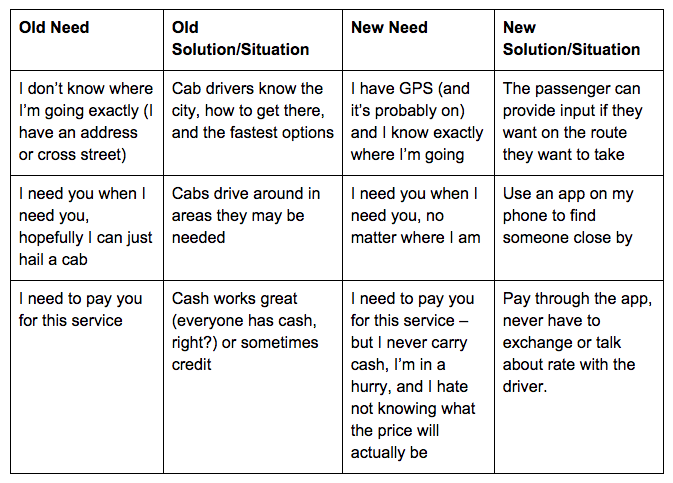
These days, everyone wants to be the “Uber/Amazon/AirBnB of {insert industry}” and even if they aren’t, they certainly like to say they are. While I don’t want to be like those other guys… I kind of can’t help myself here. So bear with me on this one.
It started the other day, while I was riding in a Lyft (the other Uber, in case you aren’t familiar) to a meeting here in Seattle where I live. I noticed how my driver asked me if I had a preferred route; “Do you want me to take I-5 or the viaduct? Do you have a preference?” he asked. I didn't.
He then offered me a bottled water and asked if I had a favorite music genre to listen to, which he could turn on for the ride. The car was really clean and smelled like a pina colada, and I could tell the driver was reading my energy and mood to determine how chatty to be with me that day.
I flashbacked to 10 minutes prior when I was wrapping up something in my home, running a few minutes behind schedule, and with a couple clicks on my phone I had a driver on the way. I could track how close they were and head out the front door to meet him almost exactly when he was pulling into my driveway. I didn't have to worry about being late because I knew exactly where my driver was and the app even provided an ETA. Plus, when the ride was over I didn't have to exchange a dollar or fumble for my credit card. I said goodbye and was walking into my meeting in seconds.
Immediately after exiting the vehicle, my mind started to wander about how the needs that cab drivers filled 10+ years ago have drastically changed, which is obviously why companies like Uber and Lyft are so incredibly successful today. Like this (just to name a few):

While these examples don’t even get into how Uber and Lyft have addressed other consumer trends like a better customer experience, customer service, tracking/receipts, safety, and many more, they showcase how the essential role that cab drivers play has been fundamentally changed due to technology.
Nobody is arguing that technology hasn’t drastically changed our lives. We know it. We live it every single day.
Then, I ask you, why have we not looked at our own—not so obvious—business models and started to really dissect how the needs of our customers have changed, yet our solutions haven’t? If you asked major cab companies if this change was obvious to them 10 years ago (or fewer), they would have never seen it coming. They didn’t see it coming.
What is your business oblivious to? What is missing?
I have some ideas. Let’s look at a local TV or radio stations as an example. The way we’ve targeted, approached, and engaged with potential advertisers hasn’t changed very much in the last 10, let alone 30, years. It probably looks something like this in its simplest form:
- Create a list of potential prospects and research them; Identify decision makers.
- Start cold calling; Stop into their offices and leave your business cards; call and leave voicemails; email them; send them something to get their attention; maybe even connect on LinkedIn.
While, there is a time and place for all of these actions, the problem lies in the fact that technology has greatly impacted the way that businesses research and buy advertising.
Media salespeople used to be the only way for businesses to get information on stations, audience, and rates for advertising. Media salespeople used to have all of the control (kind of like the cab driver). The advertisers got into the back seat and told the media salesperson where they wanted to end up, and the salesperson took them there. They knew where to go and how to get there, and the advertisers trusted them.
What has changed? Well, keeping with the analogy…
Advertisers now have the technology (a.k.a. the Internet) to educate themselves and research options. They don’t always need you to tell them exactly how to get the results they want, and oftentimes they lack trust that you even can. They read articles, subscribe to newsletters, visit your and your competitors' websites (if you have one), and talk to their peers on Facebook or LinkedIn.
Therefore, by the time you get them in the car with you, they are sitting in the front seat right next to you and they already have a lot of information—maybe even more than you—that will help them get to where they need to go.
What does this mean for media advertising sales organizations?
It simply means you need to know your customer, and you need to not only understand the journey they are on now, but also transform your approach and marketing in order to meet them where they’re at.
In the most basic ways, this means you should:
- Have a website where potential, and current, advertisers can easily access pertinent information about your brand, stations, products, and services.
- Use this online space to educate them. (If you don’t, someone else will.)
- Regularly create and publish content that answers the questions your prospects have and shows up in search, social media, and beyond.
- Not assume you know where they are at in the buyer’s journey, or knowledge level, but instead use technology and lead intelligence to better determine this information.
- Anticipate the questions and objections they will have and be prepared to answer them.
- Transform your business to not rely solely on old ways of prospecting, like 100% cold-calling by creating new streams of revenue and a consistent lead flow for your sales team.
- Utilize technology so that your salespeople are more productive, efficient, and effective.
- Make it really easy for your prospects to find the information they want, to set up appointments, to purchase something, and so on.
- Be incredibly transparent—all consumers expect and demand this.
This list could likely go on and on, but you get the point.
What can your company do to stay ahead of the evolving trends of your buyers (or possibly, to catch up)? Nobody wants to be the cab company of their industry, so start thinking like you’re the Uber instead.



